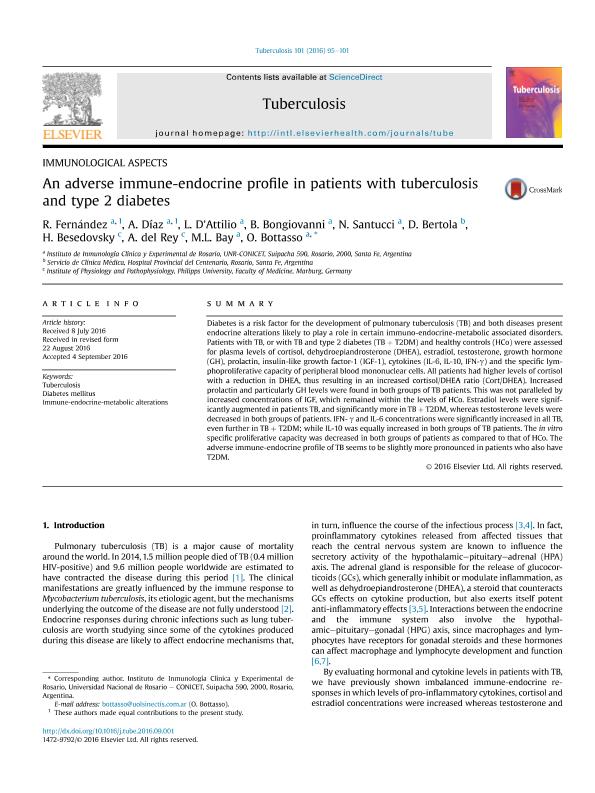Artículo
An adverse immune-endocrine profile in patients with tuberculosis and type 2 diabetes
Fernández, Rocío del Valle ; Díaz, Ariana
; Díaz, Ariana ; D'attilio, Luciano David
; D'attilio, Luciano David ; Bongiovanni, Bettina
; Bongiovanni, Bettina ; Santucci, Natalia Estefanía
; Santucci, Natalia Estefanía ; Bertola, D.; Besedovsky, H.; del Rey, A.; Bay, Maria Luisa; Bottasso, Oscar Adelmo
; Bertola, D.; Besedovsky, H.; del Rey, A.; Bay, Maria Luisa; Bottasso, Oscar Adelmo
 ; Díaz, Ariana
; Díaz, Ariana ; D'attilio, Luciano David
; D'attilio, Luciano David ; Bongiovanni, Bettina
; Bongiovanni, Bettina ; Santucci, Natalia Estefanía
; Santucci, Natalia Estefanía ; Bertola, D.; Besedovsky, H.; del Rey, A.; Bay, Maria Luisa; Bottasso, Oscar Adelmo
; Bertola, D.; Besedovsky, H.; del Rey, A.; Bay, Maria Luisa; Bottasso, Oscar Adelmo
Fecha de publicación:
12/2016
Editorial:
Elsevier
Revista:
Tuberculosis (Edinb)
ISSN:
1472-9792
Idioma:
Inglés
Tipo de recurso:
Artículo publicado
Clasificación temática:
Resumen
Diabetes is a risk factor for the development of pulmonary tuberculosis (TB) and both diseases present endocrine alterations likely to play a role in certain immuno-endocrine-metabolic associated disorders. Patients with TB, or with TB and type 2 diabetes (TB + T2DM) and healthy controls (HCo) were assessed for plasma levels of cortisol, dehydroepiandrosterone (DHEA), estradiol, testosterone, growth hormone (GH), prolactin, insulin-like growth factor-1 (IGF-1), cytokines (IL-6, IL-10, IFN-γ) and the specific lymphoproliferative capacity of peripheral blood mononuclear cells. All patients had higher levels of cortisol with a reduction in DHEA, thus resulting in an increased cortisol/DHEA ratio (Cort/DHEA). Increased prolactin and particularly GH levels were found in both groups of TB patients. This was not paralleled by increased concentrations of IGF, which remained within the levels of HCo. Estradiol levels were significantly augmented in patients TB, and significantly more in TB + T2DM, whereas testosterone levels were decreased in both groups of patients. IFN- γ and IL-6 concentrations were significantly increased in all TB, even further in TB + T2DM; while IL-10 was equally increased in both groups of TB patients. The in vitro specific proliferative capacity was decreased in both groups of patients as compared to that of HCo. The adverse immune-endocrine profile of TB seems to be slightly more pronounced in patients who also have T2DM.
Palabras clave:
Diabetes Mellitus
,
Immune-Endocrine-Metabolic Alterations
,
Tuberculosis
Archivos asociados
Licencia
Identificadores
Colecciones
Articulos(IDICER)
Articulos de INSTITUTO DE INMUNOLOGIA CLINICA Y EXPERIMENTAL DE ROSARIO
Articulos de INSTITUTO DE INMUNOLOGIA CLINICA Y EXPERIMENTAL DE ROSARIO
Citación
Fernández, Rocío del Valle; Díaz, Ariana; D'attilio, Luciano David; Bongiovanni, Bettina; Santucci, Natalia Estefanía; et al.; An adverse immune-endocrine profile in patients with tuberculosis and type 2 diabetes; Elsevier; Tuberculosis (Edinb); 101; 12-2016; 95-101
Compartir
Altmétricas



